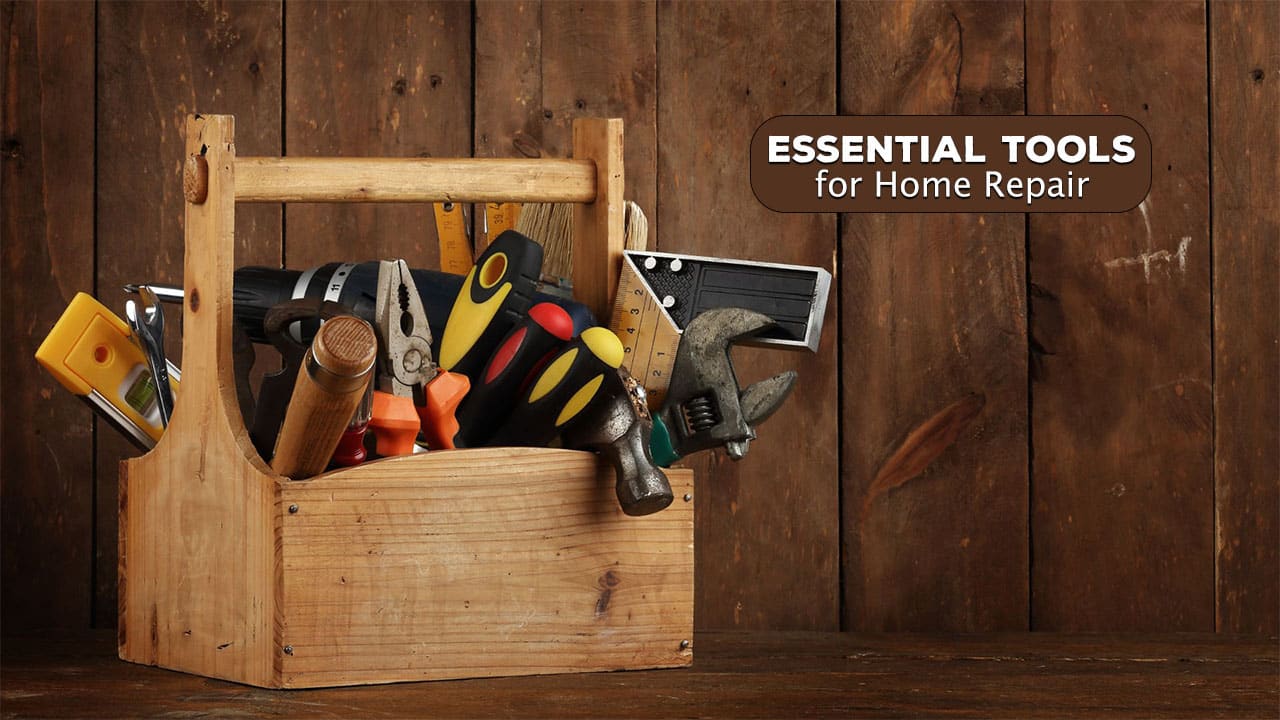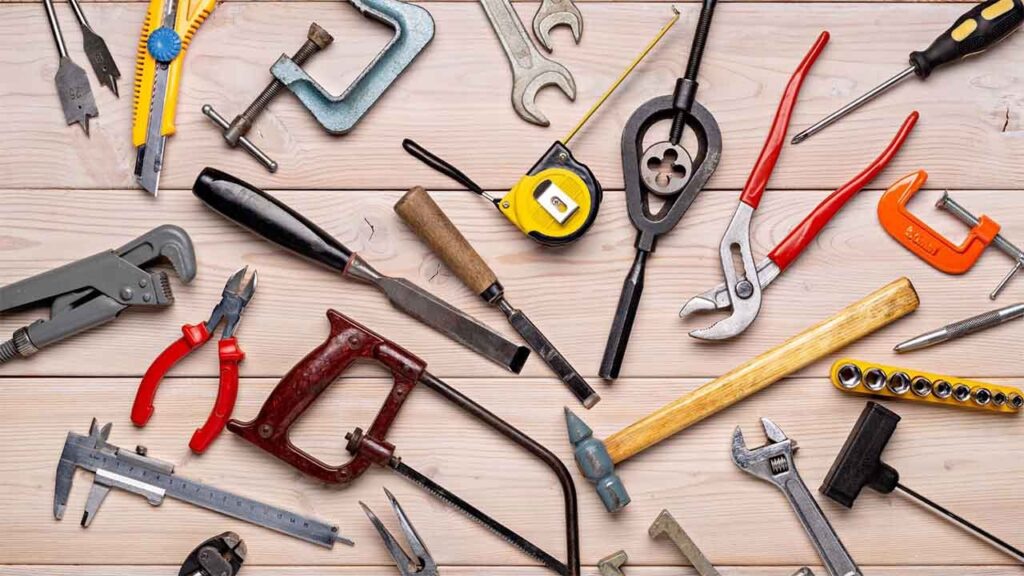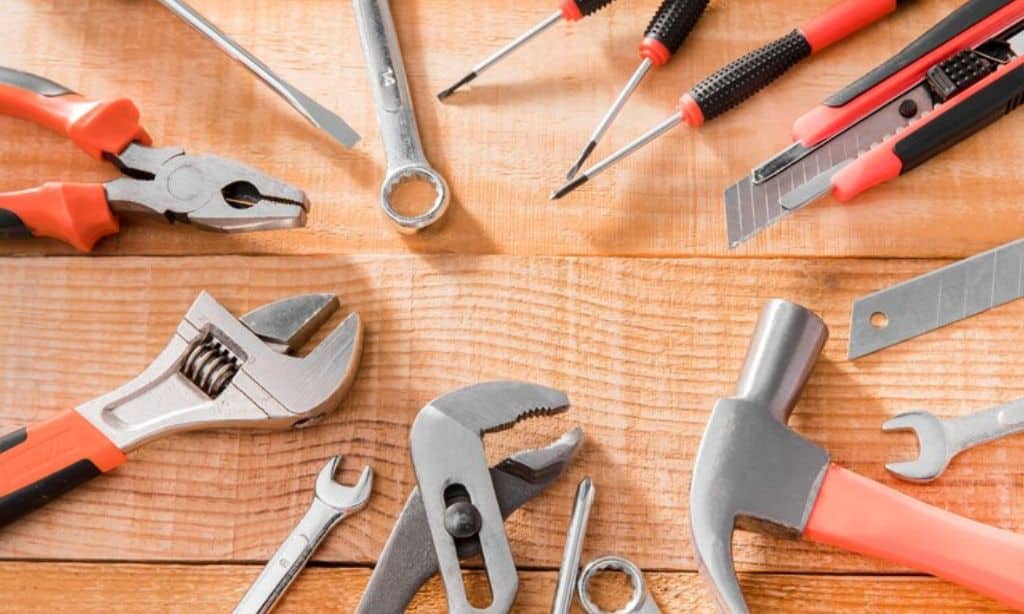Owning a home comes with many responsibilities, including maintenance and repairs. The right tools can make these tasks much easier and save you time and money. A well-stocked toolbox is a must for every homeowner.
The right tools can help you tackle common household issues quickly and efficiently. From fixing leaky faucets to hanging pictures, there are many jobs you can do yourself with the proper equipment.
This article will cover 25 essential tools that every homeowner should have on hand to keep their home in top shape.
1. Hammer
A hammer is a must-have tool for every homeowner. You’ll use it for countless tasks around the house. From hanging pictures to basic repairs, a hammer is essential.
Choose a 16-ounce claw hammer for most home projects. This site offers a good balance of power and control. The claw end helps remove nails and pry things apart.
Look for a hammer with a comfortable grip. This reduces hand fatigue during longer jobs. A fiberglass or steel handle lasts longer than wood and absorbs shock better.
Keep your hammer in an easy-to-reach spot in your toolbox. You’ll likely grab it often for quick fixes and DIY projects. With proper care, a good hammer can last for many years.
2. Screwdriver Set
A good screwdriver set is a must-have for every homeowner. You’ll use these tools constantly for all sorts of tasks around the house.
Look for a set with both flathead and Phillips head screwdrivers in various sizes. This lets you tackle different screw types and sizes.
Make sure to get screwdrivers with comfortable, non-slip handles. This gives you a better grip and reduces hand fatigue during longer jobs.
Magnetic tips are a handy feature to look for. They help hold screws in place, making it easier to start them in tight spots.
Consider getting a set that includes precision screwdrivers too. These tiny tools are perfect for working on electronics and other small items.
A screwdriver with interchangeable bits can be a space-saving option. It lets you swap out different tips as needed without having a bunch of separate tools.
Store your screwdrivers properly to keep them in good shape. A toolbox or wall-mounted rack works well to organize them and prevent damage.
3. Adjustable Wrench
An adjustable wrench is a must-have tool for every homeowner. This versatile tool can handle many tasks around the house.
The main feature of an adjustable wrench is its movable jaw. You can change the size to fit different nuts and bolts. This means you don’t need a whole set of wrenches.
Adjustable wrenches come in various sizes. A 10-inch wrench is good for most home jobs. It’s big enough for plumbing work but not too heavy to use.
When using an adjustable wrench, always turn it towards the movable jaw. This gives you more power and prevents damage to the tool.
Keep your wrench clean and oiled. This will help it last longer and work better. Store it in a dry place to prevent rust.
An adjustable wrench can help with many home repairs. You can use it to fix leaky faucets, tighten loose bolts, or assemble furniture.
Some newer models have self-ratcheting features. These let you tighten bolts without removing the wrench each time.
Choose a wrench with a comfortable grip. This will make it easier to use, especially for tough jobs.
4. Tape Measure
A tape measure is a must-have tool for every homeowner. It helps you measure spaces, objects, and materials accurately. You’ll use it for all sorts of projects around your house.
A 25-foot tape measure is a good choice for most home tasks. It’s long enough to measure rooms but still easy to handle. Look for one with clear markings in both inches and feet.
Make sure your tape measure has a sturdy hook at the end. This helps you grip surfaces and measure by yourself. A locking mechanism is also useful. It keeps the tape extended while you work.
Choose a tape measure with a wide blade. This makes it easier to read and helps it stay rigid when extended. Some models have special features like magnetic hooks or built-in pencil sharpeners.
You’ll use your tape measure for hanging pictures, buying furniture, and planning renovations. It’s also handy for measuring windows for new curtains or checking appliance sizes before you buy.
5. Cordless Drill
A cordless drill is a must-have tool for any homeowner. This versatile power tool lets you tackle many projects around the house without being tied to an outlet.
Cordless drills are great for assembling furniture, hanging shelves, and installing cabinets. You can use them to drill holes and drive screws quickly and easily.
These drills come in different sizes and power levels. For most home projects, an 18-volt drill will work well. Look for one with adjustable speed settings and a reverse function.
Choose a drill that feels comfortable in your hand. A good grip is important for control and safety. Make sure to get one with a long-lasting battery so you can finish your tasks without interruption.
Many cordless drills come with extra features like built-in LED lights. These help you see better when working in dark spaces. Some also have magnetic bit holders to keep screws and bits handy.
Remember to buy some drill bits and screwdriver bits to go with your new tool. This will let you tackle a wide range of jobs around your home.
6. Pliers
Pliers are a must-have tool for any homeowner. They come in different types, each designed for specific tasks.
Needle-nose pliers are great for gripping small objects and reaching tight spaces. You can use them to bend wires or hold tiny screws.
Adjustable pliers, also called channel locks, have movable jaws. They can grip pipes and nuts of various sizes. These are handy for plumbing jobs.
Diagonal pliers, or wire cutters, are perfect for cutting wires and small metal pieces. They have angled blades that make clean cuts.
Locking pliers, like Vise-Grips, can hold objects tightly. This leaves your hands free to work on other tasks.
Keep a set of these pliers in your toolbox. They’ll help you tackle many home repair jobs with ease.
7. Utility Knife
A utility knife is a must-have tool for every homeowner. This versatile blade can handle many cutting tasks around the house.
You’ll find countless uses for a utility knife. It’s great for opening packages, cutting carpet, trimming wallpaper, and slicing through tough materials.
Look for a knife with a retractable blade for safety. Many models store extra blades in the handle, so you always have a sharp edge ready. Choose one with a comfortable grip to reduce hand fatigue during longer jobs.
Keep your utility knife in an easily accessible spot in your toolbox. You’ll reach for it often as you tackle home improvement projects and everyday tasks.
Remember to change the blade when it gets dull. A sharp blade is safer and more effective. Always cut away from your body and use caution around the sharp edge.
8. Flashlight
A flashlight is a must-have tool for every homeowner. You never know when the power might go out or when you’ll need to inspect a dark corner.
Choose a bright LED flashlight that fits comfortably in your hand. Look for one with different brightness settings and a focused beam. This will help you see clearly in various situations.
Make sure to keep fresh batteries on hand. Or better yet, get a rechargeable flashlight. Store it in an easy-to-reach spot so you can grab it quickly when needed.
A flashlight comes in handy for many tasks around the house. Use it to check behind appliances, look in air vents, or find items in dark closets. It’s also essential for outdoor use at night.
Consider getting a headlamp too. This leaves your hands free for tasks like fixing a leaky pipe under the sink or working on your car engine.
9. Stud Finder
A stud finder is a must-have tool for any homeowner. It helps you locate wooden or metal beams behind your walls. This is crucial when hanging heavy items like TVs, shelves, or large artwork.
Stud finders come in different types. Some use magnets to detect metal nails in studs. Others use electronic sensors to find density changes in the wall.
You can get a basic stud finder for under $10. More advanced models may cost $30-$50. These often have extra features like detecting live wires or measuring depth.
To use a stud finder, turn it on and slide it across the wall. When it detects a stud, it will light up or beep. Mark the spot with a pencil. For best results, scan the wall a few times.
Remember, studs are usually spaced 16 or 24 inches apart. Once you find one, you can often measure to find the next. This can help confirm your stud finder’s accuracy.
A good stud finder can save you time and prevent wall damage. It helps you avoid hitting pipes or wires when drilling. Plus, it ensures your heavy items are securely mounted.
10. Level
A level is a must-have tool for any homeowner. It helps you hang pictures, install shelves, and make sure surfaces are flat. Levels come in different sizes, but a 24-inch model is good for most home projects.
Bubble levels are the most common type. They have small tubes filled with liquid and an air bubble. When the bubble is centered between two lines, the surface is level.
Digital levels are another option. They give you a precise readout of angles and slopes. This can be helpful for more complex projects.
You can also get a laser level. These project a straight line across walls or floors. They’re great for big jobs like tiling or installing cabinets.
When choosing a level, look for one made of sturdy material like aluminum. Make sure it has clear, easy-to-read vials. A magnetic edge can be useful for working with metal surfaces.
Remember to check your level’s accuracy regularly. Place it on a flat surface, then flip it end-over-end. The bubble should stay in the same spot both times. If not, it’s time for a new one.
11. Handsaw
A handsaw is a must-have tool for any homeowner. This simple yet effective cutting tool helps you tackle various DIY projects around the house.
You’ll find a handsaw useful for trimming tree branches, cutting wooden boards, and making quick repairs. It’s perfect for jobs where power tools might be overkill or unavailable.
When choosing a handsaw, look for one with a comfortable grip and sharp teeth. A 20-inch saw is a good all-purpose size for most household tasks. Remember to keep the blade clean and store it safely to maintain its cutting edge.
12. Allen Wrench Set
An Allen wrench set is a must-have for any homeowner. These L-shaped tools help you tighten and loosen hexagonal socket screws found in many household items.
You’ll find these screws in furniture, bikes, and even some appliances. Having a set with different sizes ensures you’re ready for any job.
Look for a set that includes both metric and imperial sizes. This way, you’ll be prepared for screws measured in millimeters or inches.
A good Allen wrench set often comes in a compact case. This makes storage easy and helps you keep track of all the pieces.
Some sets have longer handles for extra leverage. This can be helpful when dealing with tight or stubborn screws.
Remember to keep your Allen wrenches clean and dry. This will prevent rust and extend their lifespan.
With an Allen wrench set in your toolbox, you’ll be ready to tackle many common home repairs and assembly projects.
13. Caulking Gun
A caulking gun is a must-have tool for any homeowner. This handy device helps you apply caulk easily and neatly.
You’ll use it to seal gaps and cracks around windows, doors, and bathtubs. It’s also great for weatherproofing and preventing water damage.
Most caulking guns are simple to use. You just insert the caulk tube, squeeze the trigger, and apply. Look for a model with a smooth plunger rod for even application.
Some caulking guns have a built-in cutter to open caulk tubes. Others have a seal puncture tool. These features make your job easier.
Choose a durable gun made of sturdy materials like steel or aluminum. This ensures it will last for many projects.
Remember to clean your caulking gun after each use. This keeps it in good shape for next time.
14. Putty Knife
A putty knife is a must-have tool for any homeowner. This versatile implement comes in handy for many tasks around the house.
You can use a putty knife to spread spackling compound or wood filler. It’s great for fixing small holes and cracks in walls or wood surfaces.
The flat edge of a putty knife also makes it useful as a scraper. You can remove old paint, wallpaper, or caulk with ease.
When choosing a putty knife, look for one with a comfortable grip. A stainless steel blade will resist rust and last longer.
It’s a good idea to have a few different sizes of putty knives. A narrow blade works well for tight spots, while a wider one covers more area quickly.
You’ll find yourself reaching for your putty knife more often than you might expect. It’s an affordable tool that pays for itself many times over.
15. Safety Glasses
Safety glasses are a must-have tool for any homeowner. During DIY projects and repairs, they protect your eyes from flying debris, dust, and chemicals.
You should wear safety glasses for power tools like drills, saws, or sanders. They’re also important for hammering, painting, or working with materials that could splash or shatter.
Look for glasses that meet ANSI Z87.1 safety standards. This ensures they provide proper protection. Choose a comfortable pair that fits well and doesn’t slip off easily.
Some safety glasses have side shields for extra protection. Others can fit over your regular eyeglasses if you wear them. You can also find tinted options for outdoor work.
Clean your safety glasses regularly to keep them clear. Store them in a safe place when not in use to avoid scratches. Replace them if they become damaged or too worn.
Remember, your eyes are irreplaceable. Always put on your safety glasses before starting any potentially risky task around the house. It only takes a second, but it could save your sight.
16. Ladder
A ladder is a must-have tool for any homeowner. You’ll need it for many tasks around the house, both inside and out.
Ladders come in different sizes and styles. A step ladder is great for indoor use. It helps you reach high shelves or change light bulbs safely.
For outdoor jobs, an extension ladder is best. You can use it to clean gutters, paint exterior walls, or trim tall trees. Make sure to choose a ladder that’s tall enough for your needs.
Safety is key when using a ladder. Always check that it’s stable before climbing. Don’t stand on the top rung or overreach. Keep three points of contact with the ladder at all times.
Store your ladder in a dry place to prevent rust. Clean it after use, especially if it gets dirty outside. This will help it last longer.
When buying a ladder, look for one that can hold your weight plus any tools you’ll carry. Fiberglass ladders are durable and don’t conduct electricity, making them safer around power lines.
17. Workbench
A workbench is a must-have for any homeowner who likes to tackle DIY projects. It gives you a stable surface to work on and keeps your tools organized.
You can buy a pre-made workbench or build your own. Look for one with a sturdy top that can handle heavy tools and materials. Wood or metal are good choices for the surface.
Storage is key. Pick a workbench with drawers or shelves to keep your tools within reach. Some models come with pegboards for hanging frequently used items.
Make sure the height is comfortable for you to work at. A good rule of thumb is to have the surface at about waist level. This helps prevent back strain during long projects.
Consider a portable workbench if you have limited space. These fold up when not in use and can be stored easily. They’re also great for taking to job sites.
A vise is a useful add-on for your workbench. It holds materials firmly in place while you work on them. This makes tasks like sawing or drilling much easier and safer.
18. Toolbox
A good toolbox is essential for every homeowner. It keeps your tools organized and easy to find when you need them. You don’t want to waste time searching for a screwdriver or pliers when there’s a job to be done.
Choose a sturdy toolbox that can handle the weight of your tools. Look for one with multiple compartments and trays. This helps you sort your tools by type or size.
Consider a toolbox with a comfortable handle for easy carrying. Some models have wheels, which is great if you have lots of heavy tools. Make sure the latches are secure to prevent spills.
Pick a size that fits your needs. A small box works for basic tools, but you may want a larger one if you have more items. Some homeowners use a rolling cabinet for maximum storage.
Remember, your toolbox is only useful if you keep it stocked. Add new tools as you need them and replace any that break. With a well-organized toolbox, you’ll be ready to tackle any home repair job.
19. Nail Gun
A nail gun is a must-have tool for any homeowner. It saves time and effort on projects big and small. You can use it for framing, trim work, and many other tasks.
Nail guns come in different types. The most common are pneumatic and cordless models. Pneumatic nail guns need an air compressor to work. Cordless ones run on batteries.
For general home use, a finish nailer or brad nailer is often best. These are good for trim, molding, and light carpentry. They use smaller nails that leave tiny holes.
When choosing a nail gun, think about what you’ll use it for most. Look for features like depth adjustment and jam clearing. These make the tool easier to use.
Safety is key with nail guns. Always wear eye protection. Keep your fingers away from the nose of the gun. Read the manual and follow all safety rules.
A good nail gun can last for years with proper care. Clean it after each use. Oil it as the manual suggests. Store it in a dry place to prevent rust.
With a nail gun, you can tackle many home projects faster. It’s a great addition to your toolbox for both repairs and improvements.
20. Multimeter
A multimeter is a must-have tool for every homeowner. This handy device measures voltage, current, and resistance in electrical systems and devices.
You can use a multimeter to test batteries, check if outlets are working, and troubleshoot electrical problems. It’s especially useful for DIY projects and home repairs.
When choosing a multimeter, look for a digital model with basic functions. You don’t need an expensive professional-grade tool for most household tasks.
Some multimeters can detect live AC wiring, which is great for safety. Others can measure temperature or test continuity in wires.
Remember to read the instructions carefully before using a multimeter. Always turn off power sources and unplug devices before testing them.
With practice, you’ll find many uses for your multimeter around the house. It can help you save money on simple electrical repairs and avoid calling professionals for minor issues.
21. Shop Vacuum
A shop vacuum is a must-have tool for any homeowner. It’s like a regular vacuum, but much tougher. You can use it to clean up wet and dry messes both inside and outside your home.
Shop vacs are great for basements, garages, and workshops. They can handle things your normal vacuum can’t, like sawdust, metal shavings, and even small amounts of water.
Most shop vacs come with different attachments. These help you clean hard-to-reach spots. You can use them to unclog drains or clean out your car too.
When buying a shop vac, look at its power and capacity. A stronger motor means better suction. A bigger tank lets you clean longer without stopping to empty it.
Some shop vacs are quieter than others. This is important if you’ll be using it often or for long periods. Many also have wheels, making them easy to move around.
Remember to clean your shop vac regularly. This keeps it working well and prevents bad smells. Empty the tank after each use, especially if you’ve sucked up wet stuff.
A good shop vac can last for years with proper care. It’s a smart investment for any homeowner who wants to keep their space clean and tidy.
22. Plunger
A plunger is a must-have tool for every homeowner. This simple device can save you from many plumbing headaches. It’s your first line of defense against clogs in toilets, sinks, and drains.
Plungers come in two main types: cup and flange. The cup plunger works best for flat surfaces like sinks and bathtubs. The flange plunger is ideal for toilets.
To use a plunger, make sure there’s enough water to cover the rubber part. Place it over the drain and push down firmly. Then pull up quickly to create suction. Repeat this motion several times.
Keep your plunger clean and store it in a dry place. This will help it last longer and be ready when you need it. You can find plungers at most hardware stores for a low price.
Remember, a plunger can often fix clogs without harsh chemicals. It’s a simple, eco-friendly solution to common plumbing problems. Keep one handy in each bathroom of your home.
23. Extension Cord
An extension cord is a must-have tool for any homeowner. It lets you use power tools and devices far from outlets. You can work in your yard or garage with ease.
Choose a heavy-duty cord that’s safe for indoor and outdoor use. Look for one with a three-prong grounded plug. This ensures better safety when using high-powered tools.
Get cords in different lengths. A 25-foot cord works well for most tasks around the house. For bigger yards or homes, consider longer options too.
Make sure your extension cord can handle the power needs of your tools. Check the amperage rating to match your equipment. This prevents overheating and potential hazards.
Store your cords properly to avoid tangles and damage. Some come with built-in reels for easy storage. This keeps your workspace tidy and extends the life of your cords.
24. Socket Set
A socket set is a must-have for any homeowner. It helps you tackle various repair and maintenance tasks around the house.
Socket sets come with different sizes of sockets that fit onto a ratchet handle. This lets you tighten or loosen nuts and bolts quickly and easily.
You’ll want a set with both metric and standard sizes. Look for one that includes at least 25 sockets. This will cover most common household needs.
A good socket set also comes with extensions. These let you reach tight spots that would be hard to access otherwise.
Make sure to get a set with a sturdy case. This keeps all your sockets organized and easy to find when you need them.
You can use your socket set for many jobs. It’s great for assembling furniture, working on appliances, or fixing your car.
With a socket set, you’ll be ready to handle many DIY projects. It’s an investment that will pay off time and time again.
25. Wire Strippers
Wire strippers are a must-have tool for any homeowner. They help you remove the plastic coating from electrical wires safely and quickly. This makes it easier to connect wires for various home projects.
You’ll find wire strippers useful when installing new outlets, light fixtures, or appliances. They come in different sizes to match various wire gauges. Some models can also cut and crimp wires.
Using wire strippers is simple. Just place the wire in the right-sized notch and squeeze. The tool will cleanly remove the insulation without damaging the wire inside. This helps prevent short circuits and ensures good electrical connections.
When buying wire strippers, look for comfortable handles and clearly marked wire sizes. A quality pair will last for years and make your electrical tasks much easier. Keep them in your toolbox for whenever you need to work with wires around your home.
Understanding Basic Tools
Having the right tools is key for homeowners. Quality tools make jobs easier and safer. Let’s look at why good tools matter and how to use them safely.
Importance of Quality
Quality tools last longer and work better. Cheap tools can break or fail when you need them most. Good tools save time and frustration.
Look for tools made of strong materials like steel. Avoid plastic for heavy-duty jobs. Brand names often offer better quality, but read reviews too.
Good tools have comfortable grips. This helps you work longer without getting tired. Ergonomic designs reduce hand strain.
Investing in quality now saves money later. You won’t need to replace tools as often. Plus, you can finish jobs faster and better.
Safety Considerations
Safety should always come first when using tools. Wear safety glasses to protect your eyes. Use work gloves to guard your hands.
Read tool manuals before use. They explain proper techniques and safety tips. Follow all warnings and instructions.
Keep tools clean and sharp. Dull or dirty tools can slip and cause injuries. Oil moving parts to keep them working smoothly.
Store tools safely when not in use. A tool box or pegboard keeps things organized. This prevents accidents and damage.
Use the right tool for each job. Don’t force a tool to do something it’s not made for. This can break the tool or hurt you.
Tool Maintenance and Care
Taking care of your tools helps them last longer and work better. Good maintenance keeps your tools safe and ready to use when you need them.
Cleaning and Storage
Clean your tools after each use. Wipe off dirt, dust, and debris with a cloth. For tougher grime, use soap and water. Dry tools completely to prevent rust.
Store tools in a dry place. A toolbox or pegboard keeps them organized. Keep metal tools away from moisture. Use silica gel packets in storage areas to absorb excess humidity.
Oil moving parts of tools regularly. This keeps them working smoothly. Apply a thin coat of oil to prevent rust on metal surfaces.
Regular Inspections
Check your tools often for damage. Look for cracks, chips, or loose parts. Replace damaged tools right away. They can be dangerous to use.
Test power tools before big jobs. Make sure they run properly and safely. Check cords for fraying or exposed wires.
Sharpen blades and cutting tools when they get dull. Sharp tools work better and are safer to use. You can sharpen many tools at home or take them to a professional.
Tighten loose screws and bolts. Wobbly tools can be hard to use and may break. Keep allen wrenches handy for quick adjustments.
Advanced Tool Utilization
Using tools skillfully can save time and money on home projects. Knowing how to use tools properly helps you tackle more complex tasks and repairs yourself.
DIY Projects
Power drills are great for home DIY projects. You can use them to hang shelves, install cabinet hardware, and assemble furniture. A circular saw helps cut wood for building decks or fences. Use a level to make sure everything is straight.
For painting, invest in quality brushes and rollers. They give smoother finishes and last longer. A paint sprayer speeds up large jobs like fences or exterior walls. Sanding blocks help prep surfaces before painting.
Learn to use a stud finder to locate wall studs. This lets you hang heavy items securely. A caulk gun seals gaps around windows, doors, and trim. It prevents drafts and water leaks.
Home Repairs
Fix plumbing issues with pipe wrenches and pliers. Unclog drains using a plumber’s snake. Patch drywall holes with spackle, a putty knife, and sandpaper.
For electrical work, use a voltage tester to check if wires are live. Wire strippers help prepare wires for connections. Learn how to use a multimeter to diagnose electrical problems.
Patching concrete cracks? Use a masonry chisel and hammer to widen the crack first. Then apply the concrete patch with a trowel. For wood repairs, wood filler and a putty knife work well.
A wet/dry shop vac cleans up after projects and removes water from floods or leaks. It’s a must-have for any DIY homeowner.
Final Thoughts
Having the right tools is essential for every homeowner, whether you’re handling routine maintenance or tackling unexpected repairs.
The 25 tools highlighted in this guide are fundamental for keeping your home in top shape and addressing a wide range of tasks with confidence. Investing in quality tools not only makes your work easier but also ensures safety and longevity, saving you time and money in the long run.
By equipping yourself with these essential tools, you’ll be prepared to take on any home project, big or small, and maintain your living space efficiently and effectively. A well-stocked toolbox is not just a convenience—it’s a key component of successful homeownership.














































